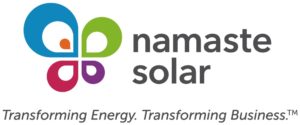How do you scale a co-operative? This was the challenge facing Namasté Solar, a workers co-operative based in Boulder USA. Set up by first time entrepreneurs in 2005 it aimed to provide innovative solar electric to Colorado and to distribute the benefits of its success to future employees. But when the cooperative needed finance to grow it looked as though it would have to compromise those ideals.

In their paper “Scaling Co-operatives Through a Multi-Stakeholder Network: A Case Study in the Colorado Solar Energy Industry” authors Júlia Martins Rodrigues and Nathan Schneider discuss how the cooperative developed an adaptive network of distinct and yet interlocking entities that enabled support for a diverse set of stakeholders while retaining the focus of each business.
Cooperatives face barriers to growth
A major obstacle facing co-operatives is access to finance. Their commitment to member control means co-operatives often cannot deliver the returns that investors expect and most business metrics are based on assumptions of market capitalisation and turnover based on investor ownership.
Additionally, rather than vertical growth, cooperatives scale through their informal networks, strongly orientated by their cultural, political and economic context. Common models include: ‘cooperation among co-operatives’ or through federation – the formation of similar, secondary co-operatives.
A different and promising strategy is that of a multi-stakeholder network – that embraces co-operative businesses with different stakeholder structures each tailored to achieve specific social and business goals. Together the entities are able to scale without incurring penalties for the others in the network.
In their paper Martins Rodrigues and Schneider explore how a strategy of multi-stakeholder networking can enable co-ops to align diverse incentives, achieve social goals, and retain democratic accountability while influencing an industry at a national scale.
They conclude that a multi-stakeholder network strategy also appears flexible enough to be replicated in other contexts and industries since it is not dependent on unusual policy arrangements.
Case-study – the Namasté network
Namasté Solar is a solar electric systems contractor that developed into a worker-owned co-op. To balance environmental impact, survival, and growth, Namasté Solar incubated a national-scale ecosystem through a series of sibling co-operatives: Amicus Solar (a purchasing co-op), Amicus O&M (a shared-services co-op), Clean Energy Credit Union (a consumer-owned financial institution), and Kachuwa Impact Fund (a co-op of investors).
These ventures contribute to the ambitions of the others, particularly through the combination of scale-friendly structures (the credit union and the purchasing co-op) with local, participatory structures (the worker co-op and allied small businesses). Yet as independent entities, each business remains relatively small and nimble in its operations.
Together, as the “Namasté network, they have contributed to reshaping their industry nationally.
Namasté Solar
 Boulder, Colorado, enjoys a strong, vibrant start-up community with a high entrepreneurial density. Namasté Solar was set up by three co-founders who each contributed capital in unequal degrees. The founders only discovered the concept of a co-operative after the company was established, but it reflected their ethos of creating a company that would generate a return on investment and distribute benefits of its success to future employees.
Boulder, Colorado, enjoys a strong, vibrant start-up community with a high entrepreneurial density. Namasté Solar was set up by three co-founders who each contributed capital in unequal degrees. The founders only discovered the concept of a co-operative after the company was established, but it reflected their ethos of creating a company that would generate a return on investment and distribute benefits of its success to future employees.
The company grew to 200 workers in 15 years, and the ownership model began to creak.
Early co-owners were able to acquired more shares than later owners and this seemed at odds with the company’s values and governance. There was a period when the company’s leaders considered bids for its acquisition. The potential buyers argued that they could help Namasté Solar compete against an investor backed competitor.
After refusing both acquisition offers, the employees chose an alternative route: keeping control of Namasté Solar by converting it to a worker-owned co-operative while achieving economies of scale by creating a national purchasing co-op, Amicus Solar.
Amicus Solar
After an unsuccessful attempt to expand into other states, Namasté Solar decided to stay close to its roots and use an alternative strategy to grow geographically.

Amicus Solar is another co-operative with a different stakeholder structure—a purchasing co-op — owned not by its employees but by companies that buy solar equipment jointly. The co-operative model allows member companies to remain independently owned and locally operated while uniting their market power.
Amicus Solar has been profitable since it started and remains a lean business with only 4 employees. It has not required external finance but instead relies on a one-time investment from its members and advice from others that have set up co-operatives. This knowledge-sharing, now on a digital platform, has helped to reduce legal costs. The profits are shared.
As of 2021, Amicus has attracted companies all over the United States, reaching 63 members, and it has extended operations to Canada and Puerto Rico as well. Members are carefully vetted to ensure they share a similar ethos and values. The members generate over 750 million USD in revenue annually.
Amicus Operations and Maintenance (O&M)
By 2016, Amicus Solar member companies had identified another common challenge, alongside the need for bulk purchasing; many had difficulties selling operations and maintenance service contracts.
In the solar industry, such follow-on services are typically necessary after an installation takes place and this is challenging over large distances.
As part of the US Department of Energy’s SunShot Initiative, Amicus Solar was awarded $358,000 to create a sister co-op; Amicus Operations and Maintenance (O&M).
This co-op has a different structure – whereas Amicus Solar’s bulk purchasing occurs through a hub-and-spoke system, in which member companies place their orders through the central co-op, Amicus O&M operates as a subcontractor network, facilitating contracts between its members and their various clients.
This relationship-based contracting model has proved more difficult to police as there is now an intermediate in the client relationship, so maintaining high standards of trust and efficient communication are critical priorities.
Clean Energy Credit Union
By 2014, Amicus Solar member companies identified financing as an obstacle that hindered their ability to attract new customers.
They decided to create a new financial institution. This also involved creating a co-operative with its own distinct stakeholder base, this would be a financial institution would be owned by consumers—its depositors.
Due to its nonprofit and co-operative model, the Clean Energy Credit Union offers low-cost, long-term loans that enable homeowners and businesses to keep their payments manageable with the help of energy bill savings.
Members who deposit money in the credit union can earn interest on their savings while knowing that the funds will be used solely to help others afford their clean energy projects.
Although the Clean Energy Credit Union is not controlled by Namasté Solar or the Amicus co-ops, it is part of a common ecosystem, with common leaders, and contributes to the common objective of expanding the renewable energy market through values-driven business.
Kachuwa Impact Fund
Throughout the growth of the Namasté network there had been difficulty in accessing investment capital for co-operatives.
Blake Jones, one of the founder members of Namasté Solar set up the Kachuwa Impact Fund in 2005. Initially he used it to transition his personal financial holdings into impact investments in privately held companies, but then in 2016, Jones stepped down as CEO of Namasté Solar to expand Kachuwa as an investment co-op. Described by Jones as “a mutual fund in Main Street instead of a mutual fund in Wall Street”.
Kachuwa is a co-operative and public-benefit corporation formed under Colorado law. Democratically owned and controlled by its investor members, the co-op maintains a portfolio of “impact real estate” (60% of its assets) and “impact companies” (40% of its assets).
Through its various investment types, Kachuwa improves access to capital for values-centered, co-operative, and employee-owned businesses. It introduces investors as another stakeholder class in the Namasté network—yet, by confining them to an investment co-op specifically, protects the other co-operatives from undue investor interference.
An opportunistic network
The Namasté Network has evolved in a stepwise process of problem-solving, and it has created a number of distinct stakeholder models as needs and opportunities emerged.
It has successfully scaled while also achieving a balance between stability for more established ventures and lean entrepreneurship for the newer ones. It is an ingenious design that exemplifies a ‘complex adaptive system’ that has been able to create economies of scale and cultivate capital access without resorting to conglomeration.
While, the model is not a formula and requires creativity and deep understanding of market conditions, it does have a number of characteristics that are replicable:
- Achieves economies of scale – by combining ‘heavy’ local entities (employees and non-liquid capital) with leaner lighter entities
- Addresses well defined challenges with separate business entities
- Promotes dynamism by creating new businesses alongside established ones
- Builds a shared culture to compensate for weak structural ties.
In conclusion
The multi-stakeholder network offers co-operative developers a strategy for achieving ambitious goals that need not be limited to the solar energy sector.
Taken together, the Namasté Network includes one of the largest worker co-ops in the United States, purchasing power that reaches across North America, and a financial network for both solar consumers and aligned businesses. And this has been achieved not by channelling profit from the edges of the network to the investors at its center, but by distributing surpluses to the member businesses, workers, and consumers at its edges.
Read the full paper
“Scaling Co-operatives Through a Multi-Stakeholder Network: A Case Study in the Colorado Solar Energy Industry” authors: Júlia Martins Rodrigues, Nathan Schneider, JEOD, Vol.10 Issue2 (2021)
Paper recommended by Silvia Sacchetti, Professor in Economic Policy, University of Trento and editor of Journal of Entrepreneurial and Organizational Diversity.

